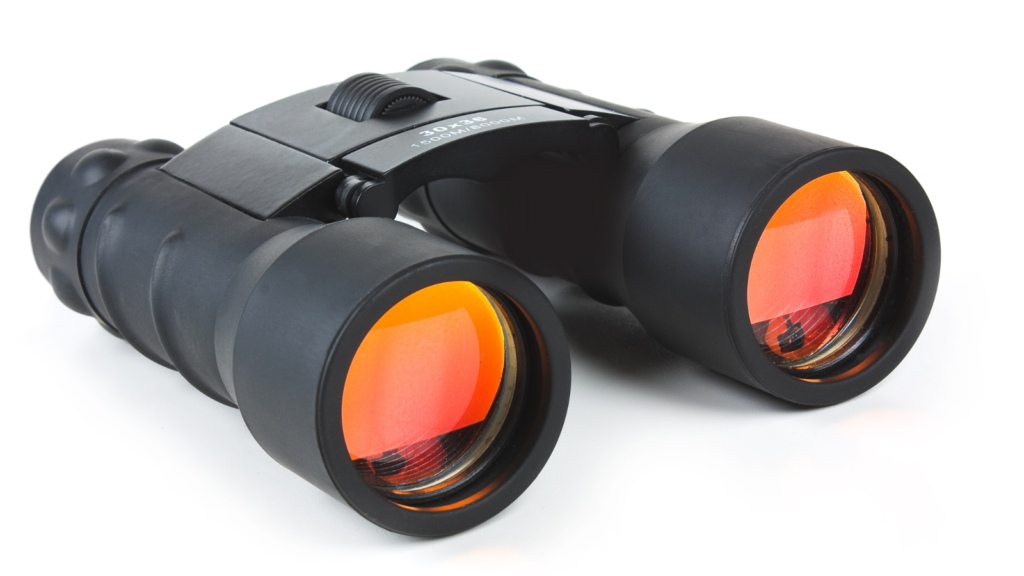The first time I used night vision binoculars, I felt like a spy. I could see clearly in the dark—it was terrific! But how do night vision binoculars work? If you’ve ever been curious, you’re not alone. In this guide, I’ll explain it in simple terms. Whether you want to watch wildlife, boost security, or explore, knowing how night vision works can help you choose the best binoculars. Let’s dive in!
Understanding Night Vision Technology
What is night vision?
Night vision lets you see in the dark. It works by boosting the small amount of light around you. Even when it feels completely dark, there’s usually some light from the moon or stars. Night vision binoculars collect this light and make it brighter. This helps you see clearly, even at night.
How light amplification works
Night vision binoculars work by capturing and strengthening light. First, light enters through the front lens. It then hits a special part called a photocathode, which turns light into tiny electric particles called electrons. These electrons multiply inside a microchannel plate. Finally, they hit a screen that turns them back into light, creating a clear image. In simple terms, night vision takes faint light and makes it bright enough for you to see.
Difference between night vision and thermal imaging
Night vision and thermal imaging are not the same. Night vision needs light to work. It amplifies what little light is there. Thermal imaging works by detecting heat. It shows heat patterns from people, animals, or objects. Night vision gives you a clear picture, while thermal imaging shows glowing shapes. If you want to see details, use night vision. If you’re going to find warm objects in the dark, use thermal imaging.

How Night Vision Binoculars Work
How do night vision binoculars let you see in the dark? It feels like magic, but it’s all about science. These binoculars turn dim light into a bright, clear image. Let’s break it down step by step.
Image Intensification: Turning Dim Light into Clear Vision
Night vision works by boosting light. Even when it’s dark, there’s usually a little light from the stars or the moon. The binoculars catch this faint light and make it stronger. This process is called image intensification.
When light enters the binoculars, it hits a special part called a photocathode. This changes the light into tiny electric particles called electrons. These electrons go through a microchannel plate (MCP), which multiplies them. More electrons mean a brighter image. Finally, they hit a phosphor screen, turning back into light and showing you a clear picture through the eyepiece.
In simple words, night vision binoculars take weak light and make it bright so you can see in the dark.
Key Parts of Night Vision Binoculars
Night vision binoculars have a few main parts:
- Objective Lens: This lens at the front gathers light and sends it inside.
- Photocathode: This part changes light into electric particles (electrons).
- Microchannel Plate (MCP): It multiplies the electrons to make the image brighter.
- Phosphor Screen: It turns the electrons back into visible light, creating the image you see.
- Eyepiece: This is where you look to see the brightened image clearly.
Each part plays a key role in turning low light into a visible picture.
The Role of Infrared (IR) Illuminators
What happens when there’s no light at all? That’s where infrared (IR) illuminators come in. They work like a flashlight—but invisible to the naked eye. IR light shines on objects, and the binoculars pick it up, turning it into a bright image.
If you’re in complete darkness, IR illuminators make sure you can still see. This is helpful for exploring caves, dark woods, or any place without natural light.
In short, night vision binoculars work by catching and boosting light. With the help of IR illuminators, they even work in total darkness.
Night Vision Binoculars: Do They Really Work?
Have you ever wondered if night vision binoculars really work? They seem like magic, right? You can see in complete darkness. But do they live up to the hype? Let’s look at how they work in real life and clear up some common myths.
Real-Life Uses
Night vision binoculars are used in many ways. The military often uses them to see at night. Soldiers can move safely in the dark, spotting enemies without a flashlight.
Wildlife lovers use them, too. Imagine hiking at night and seeing animals in their natural habitat without disturbing them. Night vision binoculars let you do just that. They allow you to see what others can’t without scaring off the animals.
Security teams also rely on night vision binoculars. They help keep people and property safe, even when it’s pitch black outside.
Limitations and Misconceptions
But night vision binoculars aren’t perfect. They need some light to work. If you’re in complete darkness, they may not be as effective unless you use an infrared (IR) light. But even with IR, the range can be limited.
A big myth is that night vision lets you see everything in total darkness. It doesn’t. It only works by amplifying available light, so if there’s no light, it won’t work well. They also don’t do well in bright light or sunlight, which can damage the lenses.
Short Answer: Night vision binoculars work well in low light, but they need some light to work. They’re great for seeing at night but not perfect in total darkness or bright light. They’re ideal for the military, wildlife watchers, and security teams.
Do Night Vision Binoculars Work in Daylight?
You might wonder, “Can I use my night vision binoculars in the daytime?” I thought the same thing the first time I tried them during the day. But I quickly learned that night vision binoculars aren’t made for daylight use. Here’s why.
Why Night Vision Doesn’t Work in Daylight
Night vision binoculars work by making small amounts of light brighter in the dark. They use light from the moon or stars to help you see. During the day, there’s already enough light, so the binoculars can’t handle it. The bright sunlight can even damage the unique parts inside the binoculars. They’re made for low light, not for the bright sunlight we have during the day.
The Risks of Using Night Vision in Bright Light
Using night vision binoculars in full sunlight can hurt them. The parts inside, like the image intensifier, can get damaged. It’s like trying to look at the sun with regular binoculars—it can ruin them. Too much light can burn out the night vision technology, and you’ll end up with binoculars that don’t work at night anymore.
What to Use During the Day
If you want binoculars for the daytime, go for regular ones that are made for bright light. These will work well without risking any damage to your night vision gear. If you want a more flexible option, consider digital night-vision binoculars. They can work in both light and dark settings, giving you the best of both worlds.
To sum up, night vision binoculars don’t work well in daylight and can even break. Stick with regular binoculars or get digital night vision if you need something that works day and night.
Types of Night Vision Binoculars
There are different types of night vision binoculars, each with unique features. Let’s examine the different generations and types and see what sets them apart.
Generation 1 to Generation 4: Differences and Advancements in Technology
Night vision technology has come a long way. The first generation, Generation 1, was the starting point. These binoculars worked well in low light, but the image wasn’t always prominent. They are the most affordable option, making them great for beginners.
Generation 2 was a step up. The images were more transparent and brighter. The addition of a microchannel plate multiplied the light, making the picture sharper and more detailed.
Then came Generation 3. These binoculars are much more precise and have a longer-lasting performance. Due to their fantastic quality, they’re the most popular in military and security fields.
Finally, Generation 4 binoculars represent the cutting edge. They provide even clearer images, work in darker conditions, and last longer, but they come at a higher price tag.
Digital Night Vision: How it Differs from Traditional Night Vision
Digital night vision is a newer technology. Unlike traditional night vision, which uses light amplification, digital night vision works by capturing and processing images electronically. This means it can capture images even when there’s no light at all.
One of the best things about digital night vision is that it can be used during the day as well as at night. This makes it more versatile than traditional night vision, which is usually just for low-light conditions. Plus, digital night vision doesn’t wear out as quickly, and it can be less expensive.
Thermal vs. Night Vision Binoculars: Key Distinctions and Best Use Cases
While night vision binoculars amplify light, thermal binoculars detect heat. This means that thermal binoculars are better for spotting warm objects, like animals or people, in complete darkness. They show you a glowing image of the heat coming from these objects.
Night vision binoculars, on the other hand, are best when you need to see in low light and see details. They’ll help you spot something specific, like a bird in the woods, but won’t help as much in complete darkness without an infrared illuminator.
Short Answer:
- Generations 1 to 4 represent a significant improvement in clarity and functionality from essential to high-end models.
- Digital night vision can be used day and night, unlike traditional models.
- Thermal imaging detects heat, while night vision relies on light.
This version maintains the original details but simplifies the structure for better readability, making it more accessible to a broader audience.

Choosing the Right Night Vision Binoculars
So, you’re thinking about getting a pair of night vision binoculars? That’s awesome! Trust me, once you experience the magic of seeing clearly in the dark, you’ll wonder how you ever lived without them. But, with so many options out there, choosing the right pair can feel overwhelming. Don’t worry—I’ve been there, and I’ve learned a lot along the way. Let me help you make an informed decision.
Factors to Consider
Range:
One of the first things you’ll want to look at is the range. Simply put, this tells you how far you can see through your binoculars. If you’re going to use them for wildlife watching, you’ll want a pair with a more extended range. But if you’re using them in your backyard or for shorter distances, you can get away with something with less power. I once went on a night hike with a pair that had a short range and quickly realized how limiting that could be if you’re out in the open. So, think about where you’ll be using them most.
Magnification:
Magnification is like a zoom lens for your eyes. It’s essential for getting a closer view of things, like animals or far-off objects. But remember: more magnification doesn’t always mean better. Higher magnification might make the image shaky or more challenging to focus. A good balance is around 5x to 7x magnification for general use. I’ve used a pair with 7x magnification during nighttime wildlife watching, and it was just the right amount.
Battery Life:
Imagine you’re out in the wild, in the middle of a fantastic experience, and then—boom! Your night vision binoculars die. That’s the worst! Battery life is crucial, especially if you plan to use them for extended periods. Look for binoculars with long-lasting batteries (ideally, at least 10 hours). I once made the mistake of buying a cheaper model that drained its battery in just a couple of hours, and let me tell you, that wasn’t fun.
Price:
Now, this one’s essential. Night vision binoculars can get pricey, but don’t let that scare you. There are options for almost every budget. If you’re starting or only plan to use them occasionally, a more affordable model might do the trick. However, if you’re looking for something that lasts, performs well in harsh conditions, and gives you better quality, it might be worth investing a bit more. Think of it as paying for quality—it’s worth it in the long run.
Brand Recommendations:
There are a lot of brands out there, but a few stand out for delivering reliable, high-quality products. Some of my favorites include Bushnell, ATN, and Pulsar. They offer a range of models at different price points, so you can find something that suits your needs. I have used Bushnell before, and the clarity and durability were top-notch, even in colder weather. Whatever you choose, make sure to check reviews and ratings—trust me, they can save you a lot of headaches.
Personal Recommendation Based on Experience
From personal experience, I recommend the Bushnell LYNX Gen 1 Night Vision Binoculars for beginners. They’re affordable, easy to use, and offer a decent range for most casual uses. If you’re a more serious night vision enthusiast or need something for professional use, I’d go for the Pulsar Edge GS 1×20 Night Vision Binoculars. They’re higher-end but definitely worth it if you want more explicit images, better durability, and longer battery life.
In the end, choosing the proper night vision binoculars depends on your specific needs. Think about where and how often you’ll use them, and balance that with the features that matter most to you. Whether you’re using them for a midnight hike, spotting wildlife, or securing your property, there’s a perfect pair out there waiting for you. Enjoy the adventure—you’re going to love what you see!
FAQs
How do night vision binoculars work?
Night vision binoculars help you see in the dark by boosting light. Even in darkness, there’s usually a little light from the moon or stars. These binoculars collect and amplify that light to make things look brighter. If there’s no light at all, they use infrared (IR) illuminators, which work like invisible flashlights.
Can I see in total darkness?
Yes! But only if your binoculars have infrared (IR) illuminators. Regular night vision needs at least some light to work. If you’re in a pitch-black room, an IR illuminator helps by shining invisible light, which the binoculars can pick up.
Which is better: digital or regular night vision?
It depends on what you need. Regular night vision (Gen 1-4) gives a real-time, natural-looking image. Digital night vision works like a camera, letting you record and use it during the day. Digital is also cheaper. If you want the best night vision in very dark places, go for traditional models. If you want versatility, pick digital.
How far can I see?
It depends on the type:
- Gen 1: Up to 100 yards (suitable for casual use).
- Gen 2: Up to 200 yards (more precise, used by security teams).
- Gen 3 & 4: Over 300 yards (military-level clarity).
- Digital: Varies, but some match Gen 2-3 quality.
Things like fog and rain can lower visibility.
Can I use them for stargazing?
Not really. Night vision works by amplifying light, but stars are too far away. Instead of a clear sky, you’ll see a blurry glow. If you want to look at stars or planets, use a telescope or astronomical binoculars instead.
If you want to see animals or walk in the dark, night vision binoculars are great. If you want to see Saturn’s rings, go with a telescope!
Conclusion
So, there you have it! Night vision binoculars aren’t just cool spy gear—they’re powerful tools that let you see in the dark by amplifying light. Whether you’re exploring the wild, keeping an eye on your surroundings, or just geeking out on night vision tech, picking the right binoculars makes all the difference.
If you’re a beginner, a budget-friendly Gen 1 model might be enough to get you started. But if you need sharper images and a more extended range, consider Gen 2 or higher—or even digital night vision for added versatility. And remember, they’re not made for daylight, so don’t risk damaging them by using them in bright conditions!
Now, I’d love to hear from you! Have you ever tried night vision binoculars? What was your experience like? Drop your thoughts or questions in the comments—I’m happy to chat!

My name is Garrison Smith, and I am the voice behind TheNightVisionGuru.com.. With a deep passion for night vision technology, I created this space to share my experiences, insights, and expertise with enthusiasts and newcomers alike. Whether you’re exploring night vision gear for professional purposes or recreational use, I’m here to guide you through the fascinating world of seeing in the dark.

